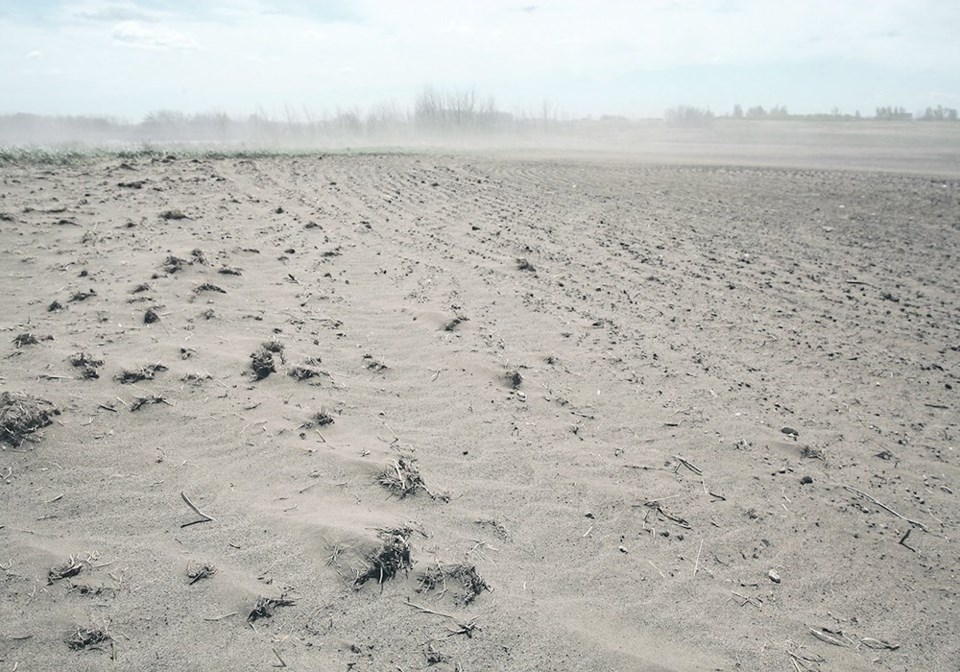WESTERN PRODUCER — What little rain that has fallen recently in southeastern Alberta and southwestern Saskatchewan has evaporated in the warm weather or been dried up by winds.
“It is dry,” said Craig Widmer, reeve of the County of 40 Mile, located in the southeastern corner of Alberta bordering Saskatchewan. “We did some sub-moisture testing last fall and we are going into this spring with very little moisture.”
The region of brown soil running from Lethbridge in the west to Oyen, Alta., in the north and running past Moose Jaw in the east is well known for having dry conditions.
to the semi-arid climate.
That assessment has been proven wrong. The area has thrived as an agricultural hub with irrigation in the western half and native pastures proving to be fertile ground for livestock.
However, the region is dry and spring of 2022 is starting out much the same as how the fall of 2021 ended, with a parched landscape dotted with low water levels in sloughs and dugouts.
What little snow cover that can be found is in tiny pockets in higher elevations around the Cypress Hills hidden from the sun and wind.
“Runoff from snow — some places got nothing; some places filled their dugouts to half full. On average, it’s about a quarter of the runoff that we usually get,” said Widmer of the situation in his county. “Right now, it is a little iffy.”
The numbers bear out that anecdotal analysis.
Maple Creek, Sask., recorded a little more than seven millimetres of precipitation in March with almost all of that coming over two days early in the month.
Medicine Hat has fared a little better with twice that amount recorded over the month but with two-thirds of it coming March 2-3.
According to Alberta Agriculture’s moisture situation update at the end of March, from Red Deer south, “these areas are in desperate need of moisture now, following a hot, dry summer and below-normal accumulations throughout the fall and winter of 2021.”
With warmer weather on the way, Alberta Agriculture reports a need for moisture to arrive very soon.
“Pastures are beginning to break dormancy and they will need moisture immediately to stimulate good growth following a dry summer, fall and winter,” read the update.
The conditions are so dry that Alberta’s Cypress County issued an early fire advisory in March, cancelling burn permits.
“We’ve had moisture in the last week, a couple of times,” said John McBain, Cypress County deputy fire chief, “But it’s just ground moisture. It’s not enough to get the fine-fuel moisture content where it needs to be.”
The high fire risk hasn’t been significantly diminished by the lack of vegetative litter left over from 2021 because the dry conditions stunted growth.
“It’s still going to burn,” said McBain.
Despite the conditions last year, McBain said they avoided any large prairie blazes and he is hoping for the same this summer.
But the region will need luck if spring rains don’t come. Alberta’s climate map indicates high fire risk as spring begins.
While current conditions aren’t great, there is some good news.
May and June are traditionally the wettest months of the year across the Palliser Triangle and the mountain runoff is predicted to be good and will recharge the South Saskatchewan watershed and irrigation reservoirs. There is also the nature of farmers and ranchers.
“Farmers are optimistic,” said Widmer. “If we get another shot of snow or get some good rain in April, it could turn around.”
For more content related to drought management visit The Dry Times, where you can find a collection of stories from our family of publications as well as links to external resources to support your decisions through these difficult times.

